Comparison of Performance-Assessment Methods for Residential PV Battery Systems
Abstract
1. Introduction
1.1. Scope
- AC-coupling: In AC-coupled systems; the battery is connected to the household installation via a bidirectional inverter (see Figure 1a), that controls the power flow of the storage system and ensures a safe and adequate battery operation. A separate PV inverter is required for connecting the PV generator and Maximum Power Point (MPP) tracking. An advantage of AC-coupling is that the PV- and the storage system may be purchased, modified, and operated independently of each other. The high number of conversion stages and associated losses which occur during charging the battery from PV is a disadvantage of this topology.
- DC-coupling: To reduce conversion losses, PV and battery use a shared inverter in DC-coupled systems (see Figure 1b). Here, the PV generator and the battery are connected on a DC link via DC/DC-converters which control the MPP tracking and the desired battery operation. With this topology losses can be significantly reduced, as no conversion to AC takes place during charging. However, increased system complexity and control requirements are disadvantages of DC-coupling.
- Generator-coupling: In generator-coupled systems, the battery is connected directly to the DC line of the PV system via a DC/DC-converter (see Figure 1c). Thus, it is charged directly by the PV generator and makes use of the PV inverter for connection to the household installation. As the battery is connected to the PV system on the DC level, this technology can be regarded as a special form of DC coupling.
1.2. Requirements for Performance-Assessment Methods
- System efficiency
- -
- Operational losses due to energy conversion, MPP tracking, and energy storage
- -
- Auxiliary losses due to standby consumption and supply of external components
- System effectiveness
- -
- Power exchange with the grid due to slow or inaccurate control of output power
- -
- Power exchange with the grid or curtailments due to unfavourable energy management
- Modular tests: Application-independent tests to separately quantify various loss mechanisms via targeted measurements of different operating states (e.g., by a separated analysis of the power flows according to Figure 2)
- Application tests: tests that focus on system performance in multiday applications based on laboratory emulations of irradiance and load profiles
1.3. Structure and Contributions
2. Materials and Methods
2.1. Test Procedures for Performance Evaluation
2.1.1. Modular Test Procedures
2.1.2. Application Test Procedures
2.2. Derivation of KPI
- Hybrid Benchmark: A combined assessment based on the results of application testing and modular tests with a focus on efficiency and effectiveness as proposed in [7,16,17] → Section 2.2.1
- SPI: An assessment via estimation of the economic benefit generated by the system, based on generic performance models (GPM) that are parameterized using test results of the Efficiency Guideline as proposed in [10] → Section 2.2.2
- Euro-Eta for PV battery systems: An assessment by aggregating the conversion and storage efficiencies identified in the Efficiency Guideline tests to a KPI as proposed in [18] → Section 2.2.3
2.2.1. Hybrid Benchmark
- MPP energy provided by the PV emulation:
- PV energy generated at the DC side of the PV system:
- AC output energy of the PV battery system:
- Load covered by PV battery system:
- Energy consumed from the grid:
- Energy fed to the grid:
2.2.2. SPI (System Performance Index)
- Energy consumed from the grid without PV battery system
- Energy consumed from the grid in the simulation of an ideal system
- Energy consumed from the grid in the simulation of a GPM
- Energy fed to the grid in the simulation of an ideal system
- Energy fed to the grid in the simulation of a GPM
2.2.3. European Efficiency for PV Battery Systems
2.3. Testbench
2.4. Devices Under Test
3. Results
3.1. Investigations of Efficiency Guideline for PV Storage Systems
3.1.1. Conversion Efficiencies
PV2AC
PV2Bat
Bat2AC
3.1.2. Battery Efficiency
3.1.3. Standby Consumption
3.1.4. Control Deviations
3.2. Results of Application Tests
3.3. Determination of Key Performance Indicators (KPIs)
3.4. Evaluation of Performance-Assessment Methodologies
4. Discussion and Conclusions
Author Contributions
Funding
Conflicts of Interest
Abbreviations
| AC | Alternating current or AC-coupled |
| AC2Bat | Charge operation (AC-coupled) |
| Aut | Self-sufficiency |
| Bat | Battery or DC point of BESS |
| Bat2AC | Discharge operation (AC-coupled, DC-coupled) |
| Bat2PV | Discharge operation (generator-coupled) |
| BESS | AC point of battery-energy storage system |
| c | Energy costs per [] |
| C | Capacity in [] or costs in [] |
| Battery capacity [] | |
| Charge | Charging of battery |
| CHP | Combined heat power |
| Con | Self-consumption |
| Household consumption | |
| D | Normalized deviation |
| Day | All values of the day |
| DC | Direct current or DC-coupled |
| Discharge | Discharging of battery |
| DuT | Device under test |
| EE | Energy efficiency |
| Efficiency Guideline | Efficiency Guideline for PV storage systems |
| Euro | Value of |
| Performance indicator | |
| f | Scaling factor |
| Energy costs for PV feed-in | |
| Gen | Generator-coupled |
| GPM | Generic performance model |
| Grid | Point of grid connection |
| GridEx | Export to grid |
| GridIm | Import from grid |
| Ideal | Simulation of ideal system |
| Irr | Solar irradiance |
| KPI | Key Performance Indicator |
| Lab | Laboratory test |
| Li-Ion | Lithium-ion |
| Load | Household consumption |
| LoadCvr | Load covered by PV battery system |
| Loss | Energy losses |
| MPP | Maximum Power Point |
| nom | Nominal (rated) value |
| OP | Operation Parameter |
| PP | Profile Parameter |
| pp | percentage points |
| PV | Photovoltaic |
| PVS | AC-side of PV system |
| PV2AC | Direct PV use operation |
| PV2Bat | Charge operation (DC-coupled, Generator-coupled) |
| R | Requirement |
| Ref | Household without PV battery system |
| SC | System Control |
| SoC | State of Charge |
| SPI | System Performance Index |
| Downtime [s] | |
| Response time [s] | |
| Tx | Energy per hour [] |
| X | Power fluctuation |
| Xmax | Maximum value of X |
| Xmean | Mean value of X |
| Xmin | Minimum value of X |
Appendix A. Derivation of Test Profiles for Application Tests
Appendix A.1. Background
Appendix A.2. Database
Appendix A.3. First Step—Profile Analysis
- Daily solar energy and daily load demand (see Figure A1a)).
- Maximum and minimum power: , and (see Figure A1a))
- The average fluctuations , and maximum fluctuations, , and by using a low-pass filtering with a ten-minute moving average (see Figure A1b)).
- Energy per hour: and
- Energy per power level: and
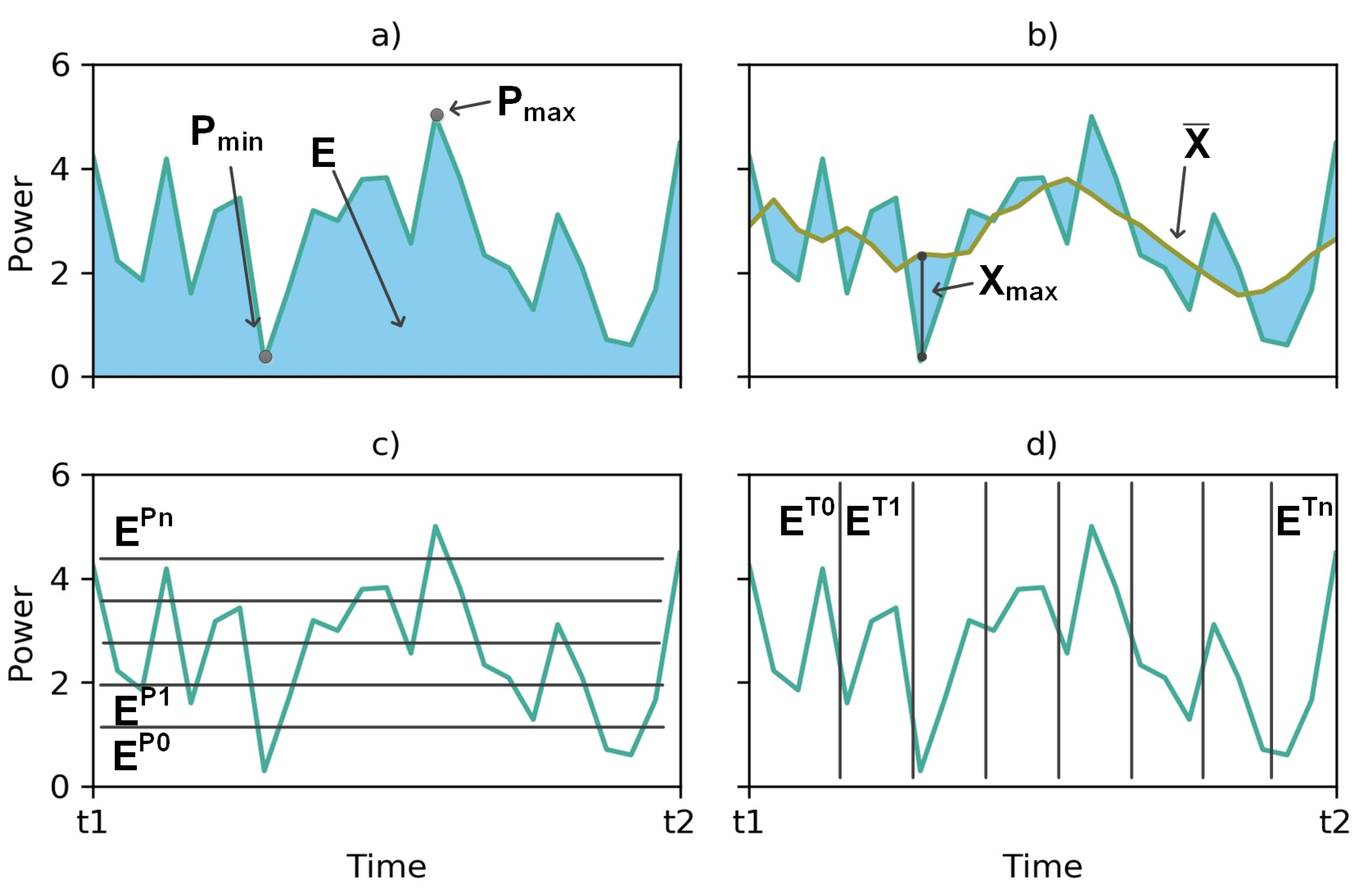
| Type | Factor | |||||||
|---|---|---|---|---|---|---|---|---|
| ∑ | ||||||||
| Irradiance | 0.40 | 0.12 | 0 | 0.21 | 0.03 | 0.14 | 0.09 | 1.0 |
| Load | 0.35 | 0.08 | 0.05 | 0.2 | 0.02 | 0.15 | 0.15 | 1.0 |

Appendix A.4. Second Step—PV Battery-System Operation Analysis
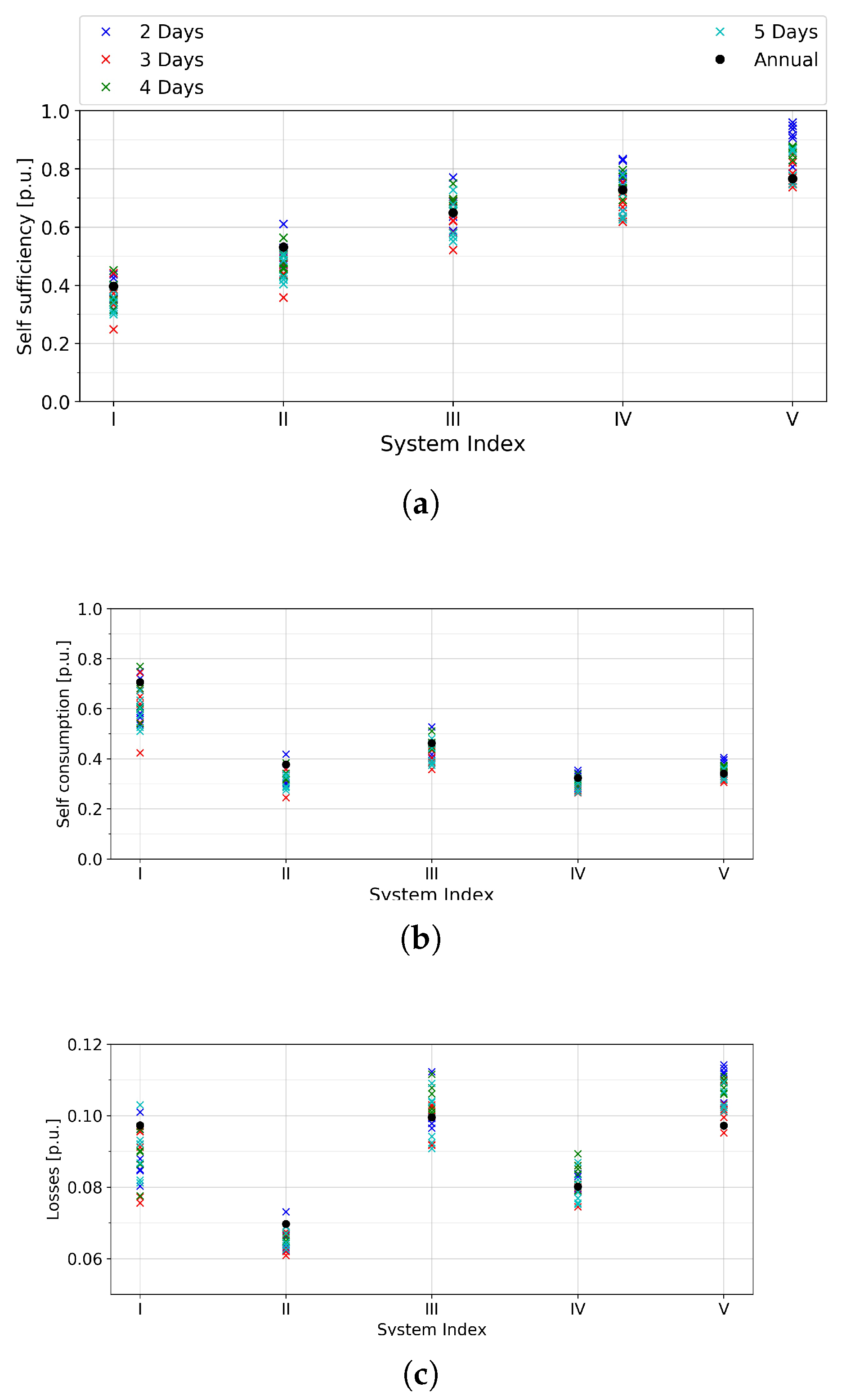
| Parameter | Reference System | ||||
|---|---|---|---|---|---|
| I | II | III | IV | V | |
| [kWh] | 2 | 2 | 5 | 5 | 8 |
| [kW] | 2 | 5 | 5 | 8 | 8 |
| [kW] | 2 | 2 | 5 | 5 | 8 |
| [kW] | 2 | 2 | 5 | 5 | 8 |

Appendix B. Datasheets of Devices under Test
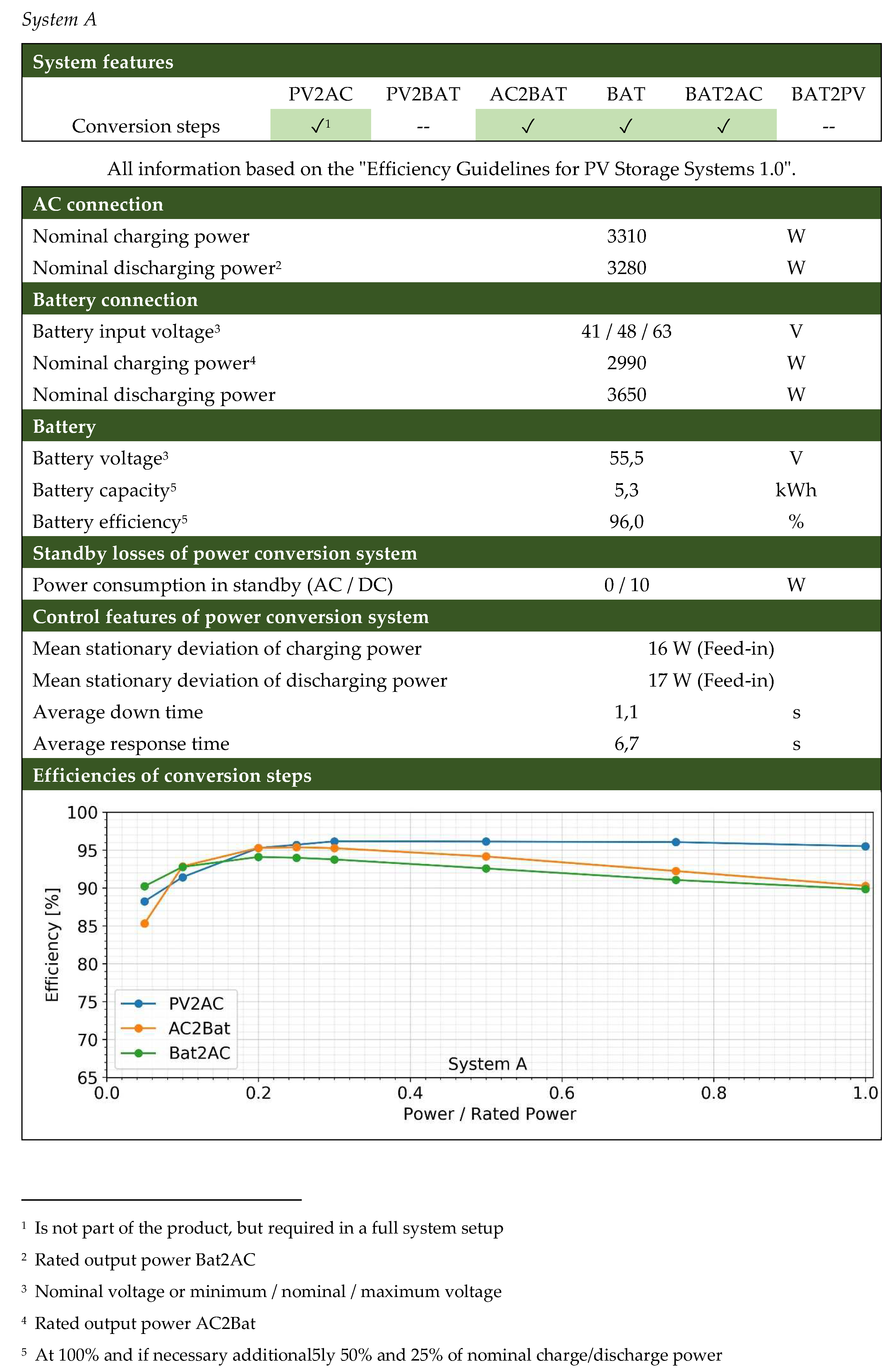
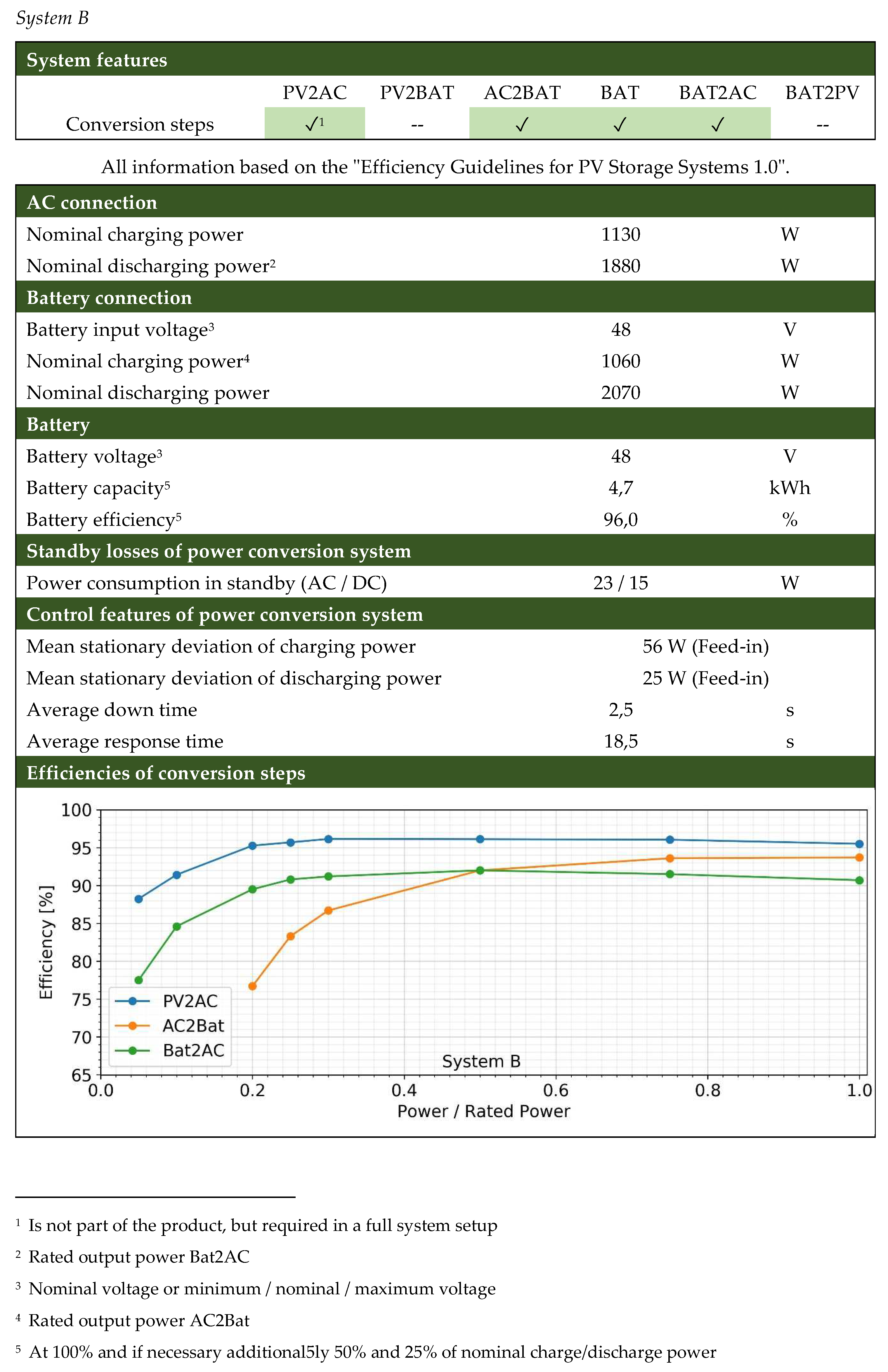


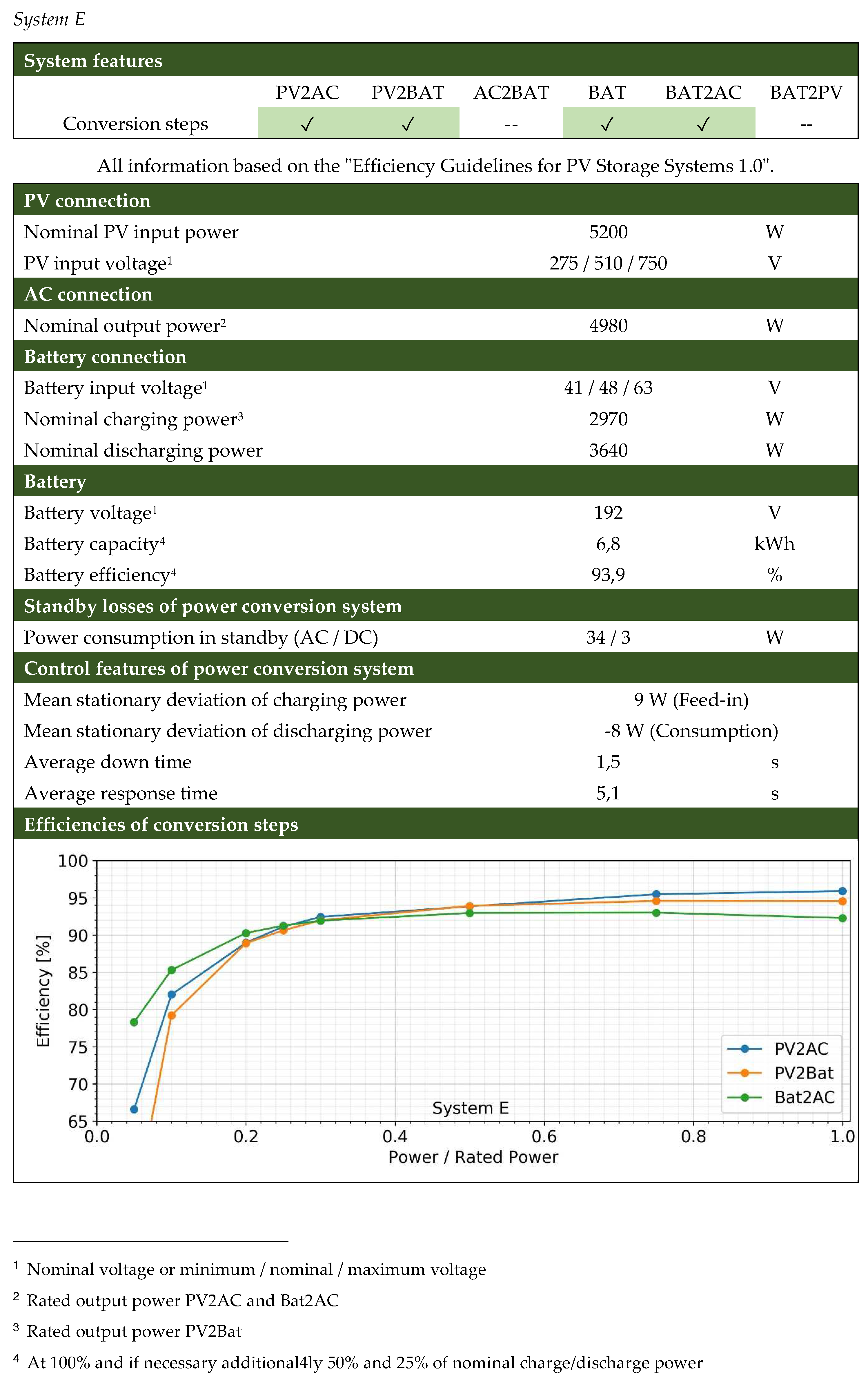
References
- Stetz, T.; von Appen, J.; Niedermeyer, F.; Scheibner, G.; Sikora, R.; Braun, M. Twilight of the grids. IEEE Power Energy Mag. 2015, 13, 50–61. [Google Scholar] [CrossRef]
- Curry, C. Lithium—Ion battery costs and market. Bloom. New Energy Financ. 2017. Available online: https://about.bnef.com/blog/global-storage-market-double-six-times-2030/ (accessed on 21 April 2020).
- Figgener, J.; Stenzel, P.; Kairies, K.P.; Linßen, J.; Haberschusz, D.; Wessels, O.; Angenendt, G.; Robinius, M.; Stolten, D.; Sauer, D.U. The development of stationary battery storage systems in Germany—A market review. J. Energy Storage 2020, 29. [Google Scholar] [CrossRef]
- Kairies, K.P.; Figgener, J.; Haberschusz, D.; Wessels, O.; Tepe, B.; Sauer, D.U. Market and technology development of PV home storage systems in Germany. J. Energy Storage 2019, 23, 416–424. [Google Scholar] [CrossRef]
- Figgener, J.; Haberschusz, D.; Kairies, K.P.; Wessels, O.; Tepe, B.; Sauer, D.U. Wissenschaftliches Mess- und Evaluierungsprogramm Solarstromspeicher 3.0—Jahresbericht 2018; Institute for Power Electronics and Electrical Drives, RWTH Aachen University: Aachen, Germany, 2018; Available online: http://www.speichermonitoring.de/fileadmin/user_upload/Speichermonitoring_Jahresbericht_2018_ISEA_RWTH_Aachen.pdf (accessed on 12 June 2020).
- Braun, M.; Büdenbender, K.; Landau, M.; Sauer, D.U.; Magnor, D.; Schmiegel, A. Charakterisierung von netzgekoppelten PV-Batterie-Systemen—Verfahren zur Bestimmung der Performance. In Proceedings of the 25th Symposium Photovoltaische Solarenergie, Bad Staffelstein, Germany, 3–5 March 2010; Available online: https://www.researchgate.net/publication/216574952_Charakterisierung_von_netzgekoppelten_PV-Batterie-Systemen_-_Verfahren_zur_vereinfachten_Bestimmung_der_Performance (accessed on 28 September 2020).
- Niedermeyer, F.; von Appen, J.; Braun, M.; Schmiegel, A.; Kreutzer, N.; Reischl, A.; Scheuerle, W. Allgemeine Performanceindikatoren für PV-Speichersysteme. In Proceedings of the 29th Symposium Photovoltaische Solarenergie, Bad Staffelstein, Germany, 12–14 March 2014. [Google Scholar]
- Efficiency Guideline for PV Storage Systems, Version 2.0; BVES Bundesverband Energiespeicher, BSW Bundesverband Solarwirtschaft. Available online: https://www.bves.de/wp-content/uploads/2019/07/EfficiencyGuideline_PV-Storage_2.0_EN.pdf (accessed on 9 June 2020).
- Electricity Prices for Household Consumers—Bi-Annual Data (from 2007 Onwards); European Commission. Eurostat: Luxembourg. Available online: http://appsso.eurostat.ec.europa.eu/nui/show.do?dataset=nrg_pc_204 (accessed on 6 June 2020).
- Weniger, J.; Tjaden, T.; Quaschning, V. Vergleich Verschiedener Kennzahlen zur Bewertung der Energetischen Performance von PV-Batteriesystemen. In Proceedings of the 32nd Symposium Photovoltaische Solarenergie, Bad Staffelstein, Germany, 8–10 March 2017; Available online: https://pvspeicher.htw-berlin.de/wp-content/uploads/2017/03/WENIGER-2017_03-Vergleich-verschiedener-Kennzahlen-zur-Bewertung-der-energetischen-Performance-von-PV-Batteriesystemen.pdf (accessed on 28 September 2020).
- Mohan, N.; Undeland, T.; Robbins, W. Power Electronics: Converters, Applications, and Design; Wiley: Hoboken, NJ, USA, 2002; Volume 3, ISBN 978-047-122-6932. [Google Scholar]
- Häberlin, H. Wirkungsgrade von Photovoltaik-Wechselrichtern. ET Elektrotechnik Aarau 2005, 56, 53–57. Available online: http://www.pvtest.ch/Dokumente/Publikationen/101_etatot_ET_02.pdf (accessed on 28 September 2020).
- Mertens, K. Photovoltaics: Fundamentals, Technology and Practice; Wiley: Hoboken, NJ, USA, 2014; Volume 1, ISBN 978-111-863-4165. [Google Scholar]
- IEC 61683:1999. Photovoltaic Systems—Power Conditioners—Procedure for Measuring Efficiency; International Standard, IEC—International Electrotechnical Commission: Geneva, Switzerland, 1999. [Google Scholar]
- Munzke, N.; Schwarz, B.; Hiller, M. Intelligent control of household Li-ion battery storage systems. Energy Procedia 2018, 155. [Google Scholar] [CrossRef]
- Niedermeyer, F.; Appen, J.V.; Braun, M.; Schmiegel, A.; Rothert, M.; Kreutzer, N. Vergleich der Performance von PV-Batteriesystemen. PV Mag. 2014, 11/14, 81–84. [Google Scholar]
- Niedermeyer, F.; von Appen, J.; Kneiske, T.; Braun, M.; Schmiegel, A.; Kreutzer, N. Innovative Performancetests für PV-Speichersysteme zur Erhöhung der Autarkie und des Eigenverbrauchs. In Proceedings of the 30th Symposium Photovoltaische Solarenergie, Bad Staffelstein, Germany, 4–6 March 2015. [Google Scholar]
- Loges, H.; Rothert, M.; Engel, B. Effizienzvergleich von PV-Speicher-Systemen. EW Magazin für die Energiewirtschaft 2017, 10/17, 42–46. [Google Scholar]
- Weniger, J.; Tjaden, T.; Bergner, J.; Quaschning, V. Emerging Performance Issues of Photovoltaic Battery Systems. In Proceedings of the 32nd European Photovoltaic Solar Energy Conference and Exhibition, Munich, Germany, 20–24 June 2016. [Google Scholar]
- Tjaden, T.; Weniger, J.; Messner, C.; Knoop, M.; Littwin, M.; Kairies, K.P.; Haberschusz, D.; Loges, H.; Quaschning, V. Offenes Simulationsmodell für netzgekoppelte PV-Batteriesysteme. In Proceedings of the 32nd Symposium Photovoltaische Solarenergie, Bad Staffelstein, Germany, 8–10 March 2017. [Google Scholar]
- Maier, S.; Weniger, J.; Böhme, N.; Quaschning, V. Simulationsbasierte Effizienzanalyse von PV-Speichersystemen. In Proceedings of the 34th Symposium Photovoltaische Solarenergie, Bad Staffelstein, Germany, 19–21 March 2019. [Google Scholar]
- Tjaden, T.; Weniger, J.; Bergner, J.; Quaschning, V. Repräsentative Elektrische Lastprofile für WOHNGEBäude in Deutschland auf 1-sekündiger Datenbasis. 2015. Available online: https://pvspeicher.htw-berlin.de/wp-content/uploads/Repräsentative-elektrische-Lastprofile-für-Wohngebäude-in-Deutschland-auf-1-sekündiger-Datenbasis.pdf (accessed on 17 June 2020).
- Despeghel, J.; Tant, J.; Driesen, J. Loss Model for Improved Efficiency Characterization of DC Coupled PV-Battery System Converters. 2019. Available online: https://ieeexplore.ieee.org/stamp/stamp.jsp?tp=&arnumber=8927644 (accessed on 17 June 2020).
- Loges, H. Entwicklung einer Energieeffizienzkennzahl für PV-Batteriespeicher. Ph.D. Thesis, Technical University of Braunschweig, Braunschweig, Germany, 2019. [Google Scholar]
- CENELEC - EN 50530:2013. Overall Efficiency of Grid Connected Photovoltaic Inverters; European Standard; CENELEC: Brussels, Belgium, 2010. [Google Scholar]
- Spitzenberger und Spies GmbH und Co. KG. Photovoltaik Simulator–PVS Serie–PVS 1000/LV—Datasheet. Available online: https://www.spitzenberger.de/weblink/1064 (accessed on 22 April 2020).
- Ram, J.P.; Manghani, H.; Pillai, D.S.; Babu, T.S.; Miyatake, M.; Rajasekar, N. Analysis on solar PV emulators: A review. Renew. Sustain. Energy Rev. 2018, 81, 149–160. [Google Scholar] [CrossRef]
- Hohm, D.; Ropp, M. Comparative study of maximum power point tracking algorithms using an experimental, programmable, maximum power point tracking test bed. In Proceedings of the 28th IEEE Photovoltaic Specialists Conference, Anchorage, AK, USA, 15–22 September 2000. [Google Scholar]
- Höcherl und Hackl GmbH. Electronic Load Series ZSAC—Operating Manual. Available online: https://www.schulz-electronic.de/fileadmin/media/ZSAC_SW_B_D-E.pdf (accessed on 22 April 2020).
- Python Software Foundation. Python Language Reference; Version 3.7.4; Python Software Foundation: Wilmington, DE, USA, 2019. [Google Scholar]
- Dewetron GmbH. DEWE 2600—Technical Reference Manual. Available online: https://www.johnmorrisgroup.com/Content/Attachments/122350/DEWE-2600_manual.pdf (accessed on 22 April 2020).
- IBC Solar AG. IBC SolStore 6.5 Li—Datasheet; IBC Solar AG.: Bad Staffelstein, Germany, 2014. [Google Scholar]
- SMA Solar Technology AG. PV inverter—Sunny Boy 3000TL/ 4000TL/ 5000TL—Datasheet; SMA Solar Technology AG.: Niestetal, Germany. Available online: http://files.sma.de/dl/15330/SB30-50TL-21-BE-en-11.pdf (accessed on 23 April 2020).
- VDI-Fachbereich Energietechnik. VDI-Fachbereich Energietechnik. VDI 4655:2008—Reference load profiles of single-family and multi-family houses for the use of CHP systems. In German Technical Guideline; VDI—Verein Deutscher Ingenieure: Berlin, Germany, 2008. [Google Scholar]
- Deutscher Wetterdienst (DWD) and Federal Institute for Research on Building, Urban Affairs and Spatial Development (BBSR). Handbuch—Ortsgenaue Testreferenzjahre von Deutschland für mittlere und extreme Witterungsverhältnisse; DWD: Offenbach, Germany, 2017. [Google Scholar]
- Remund, J.; Müller, S.C. Meteodaten für die Eigenverbrauchsberechnung. In Proceedings of the 32nd Symposium Photovoltaische Solarenergie, Bad Staffelstein, Germany, 8–10 March 2017. [Google Scholar]
- Stetz, T.; Marten, F.; Braun, M. Improved Low Voltage Grid-Integration of Photovoltaic Systems. IEEE Trans. Sustain. Energy 2013, 4, 534–542. [Google Scholar] [CrossRef]
- Von Appen, J.; Haack, J.; Braun, M. Erzeugung zeitlich hochaufgelöster Stromlastprofile für verschiedene Haushaltstypen. IEEE Power Energy Stud. Summit Stuttg. 2014. Available online: https://docplayer.org/72035549-Erzeugung-zeitlich-hochaufgeloester-stromlastprofile-fuer-verschiedene-haushaltstypen.html (accessed on 23 April 2020).
- Reese, C.; Hofmann, L. Synthetic three-phase load profiles. In Proceedings of the 22nd International Conference and Exhibition on Electricity Distribution (CIRED 2013), Stockholm, Sweden, 10–13 June 2013. [Google Scholar]
- Pflugradt, N. Modellierung von Wasser und Energieverbräuchen in Haushalten. Ph.D. Thesis, Chemnitz University of Technology, Chemnitz, Germany, 2016. [Google Scholar]
- Henze, J.; Kneiske, T.; Braun, M.; Sick, B. Identifying Representative Load Time Series for Load Flow Calculations. In Data Analytics for Renewable Energy Integration: Informing the Generation and Distribution of Renewable Energy; Springer: Berlin/Heidelberg, Germany, 2017; pp. 88–93. [Google Scholar]
- Green, R.; Stafell, I.; Vasilakos, N. Divide and Conquer? k-Means Clustering of Demand Data Allows Rapid and Accurate Simulations of the British Electricity System. IEEE Trans. Eng. Manag. 2014, 61, 251–260. [Google Scholar] [CrossRef]
- Poncelet, K.; Höschle, H.; Delarue, E.; Virag, A.; D’Haesseleer, W. Selecting Representative Days for Capturing the Implications of Integrating Intermittent Renewables in Generation Expansion Planning Problems. IEEE Trans. Power Syst. 2017, 32, 1936–1948. [Google Scholar] [CrossRef]
- Merrick, J.H. On representation of temporal variability in electricity capacity planning model. Energy Econ. 2016, 59, 261–274. [Google Scholar] [CrossRef]
- Deutscher Wetterdienst (DWD). Jahresgang der Globalstrahlung 2018 im Vergleich zum langjährigen Mittel 1981–2010; DWD: Offenbach, Germany, 2018. [Google Scholar]
- Quaschning, V. Regenerative Energiesysteme; Carl Hanser Verlag: Munich, Germany, 2015; Volume 9, pp. 80–81. ISBN 978-3-446-44267-2. [Google Scholar]
- Bundesverband der Energie- und Wasserwirtschaft (BDEW) e.V. Energie-Info: Stromverbrauch im Haushalt; BDEW: Berlin, Germany, 2013. [Google Scholar]

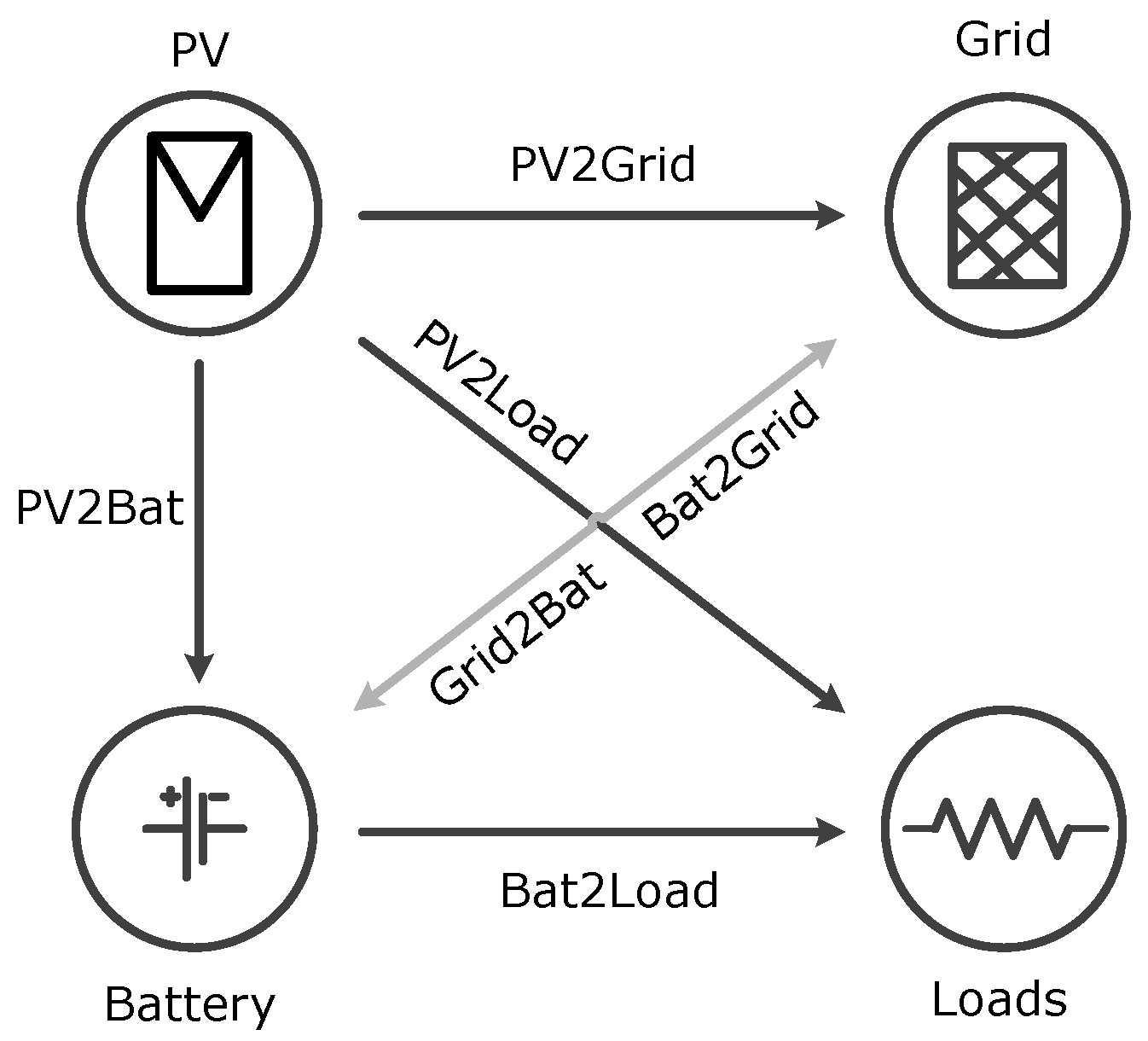
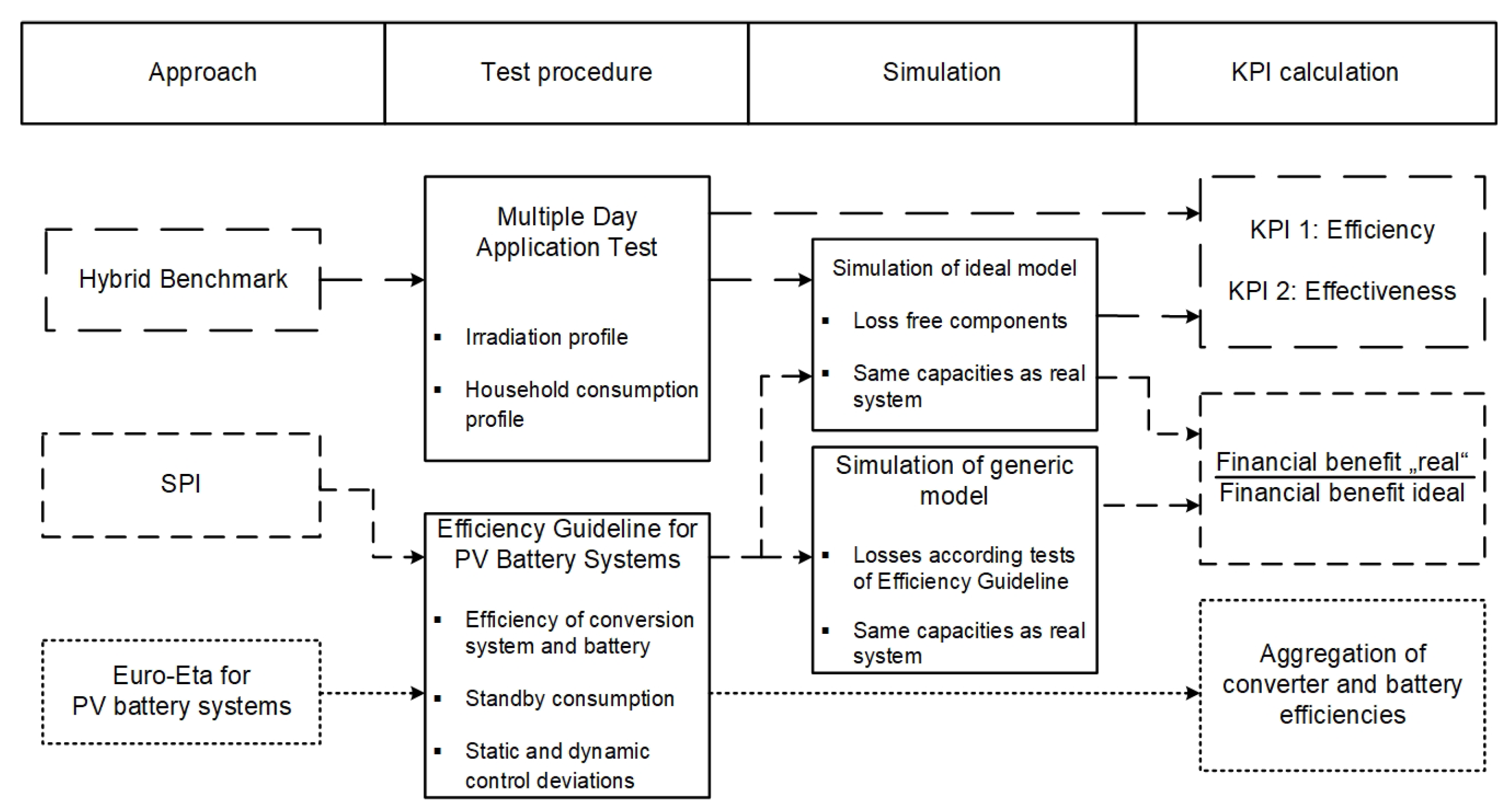

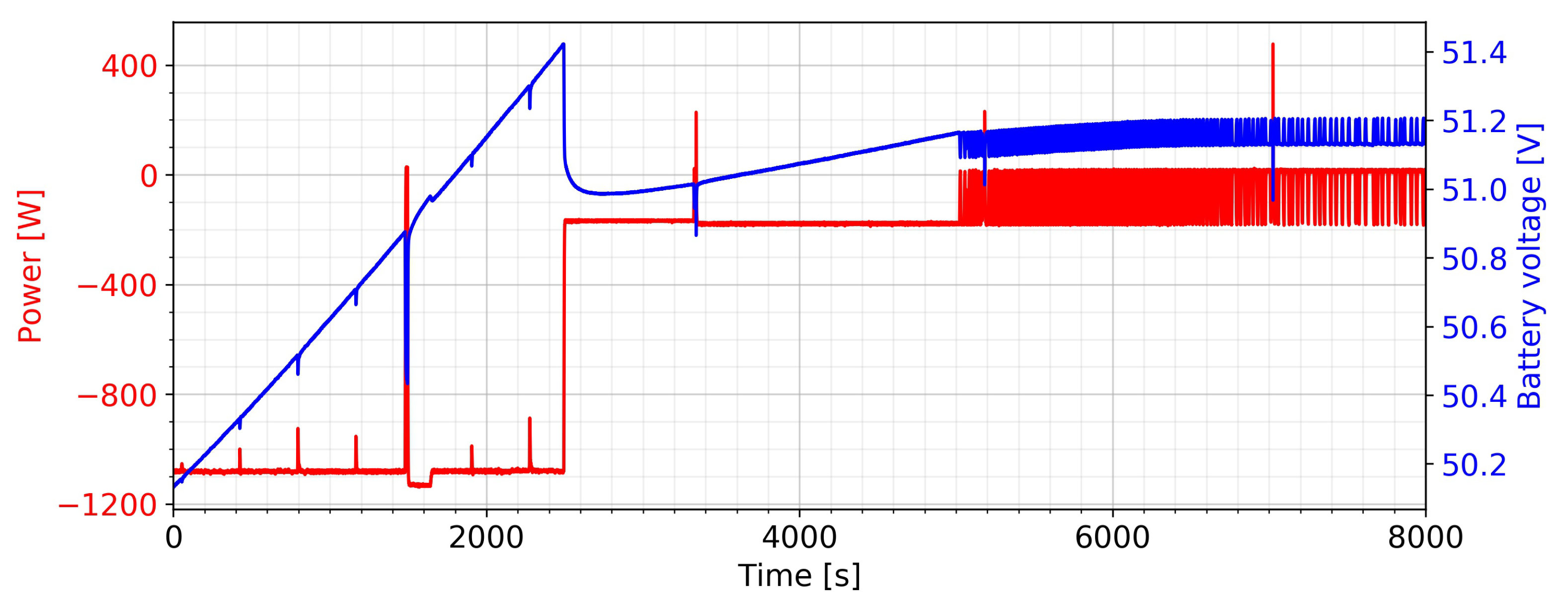
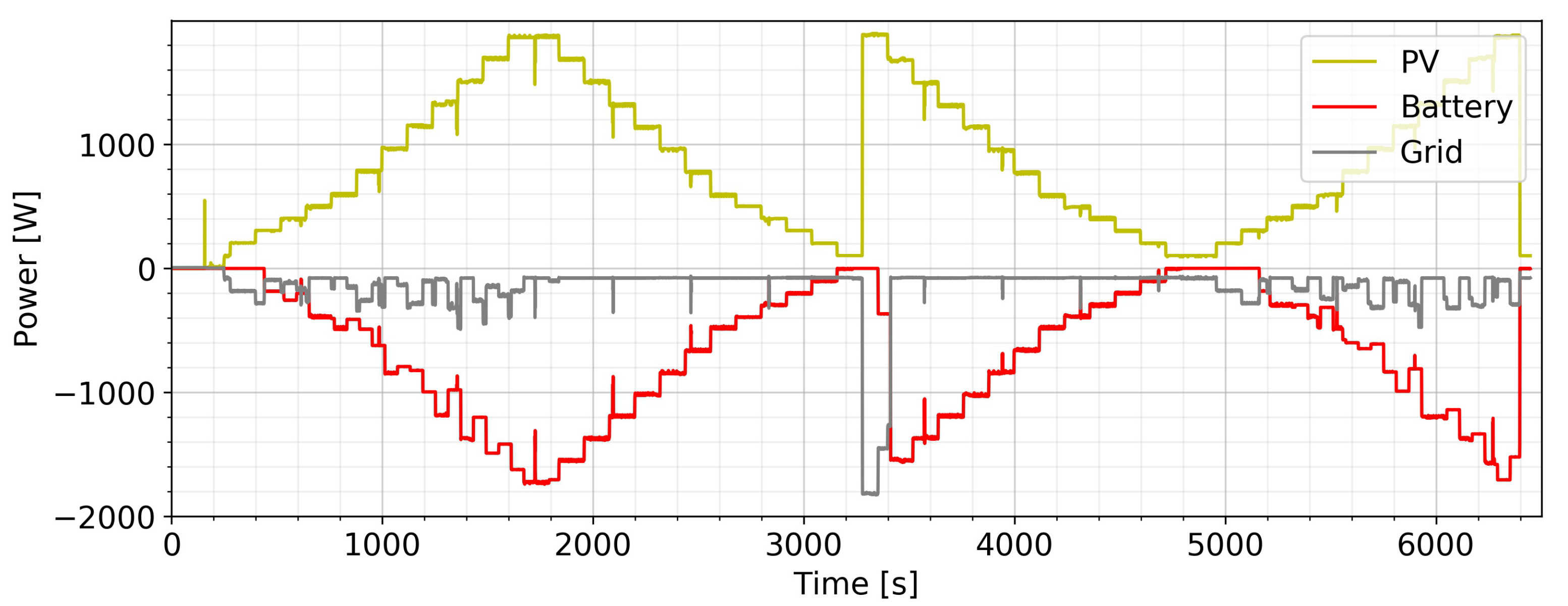
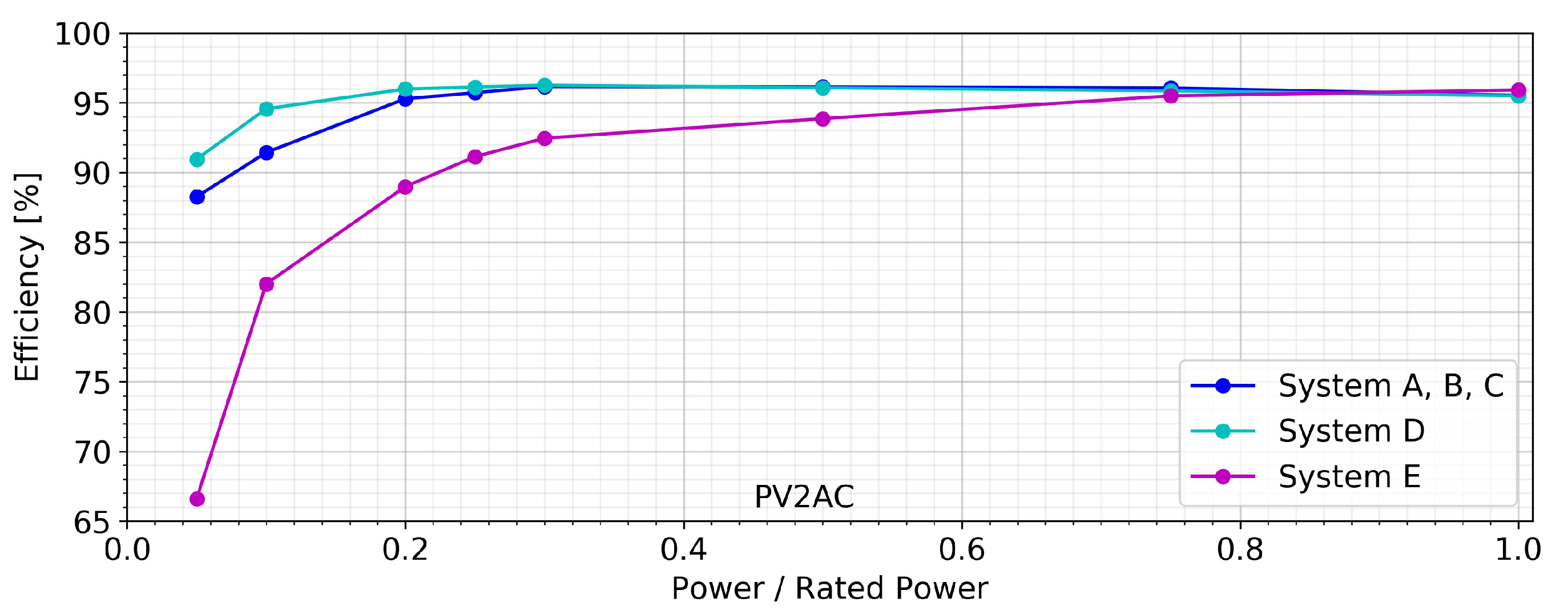
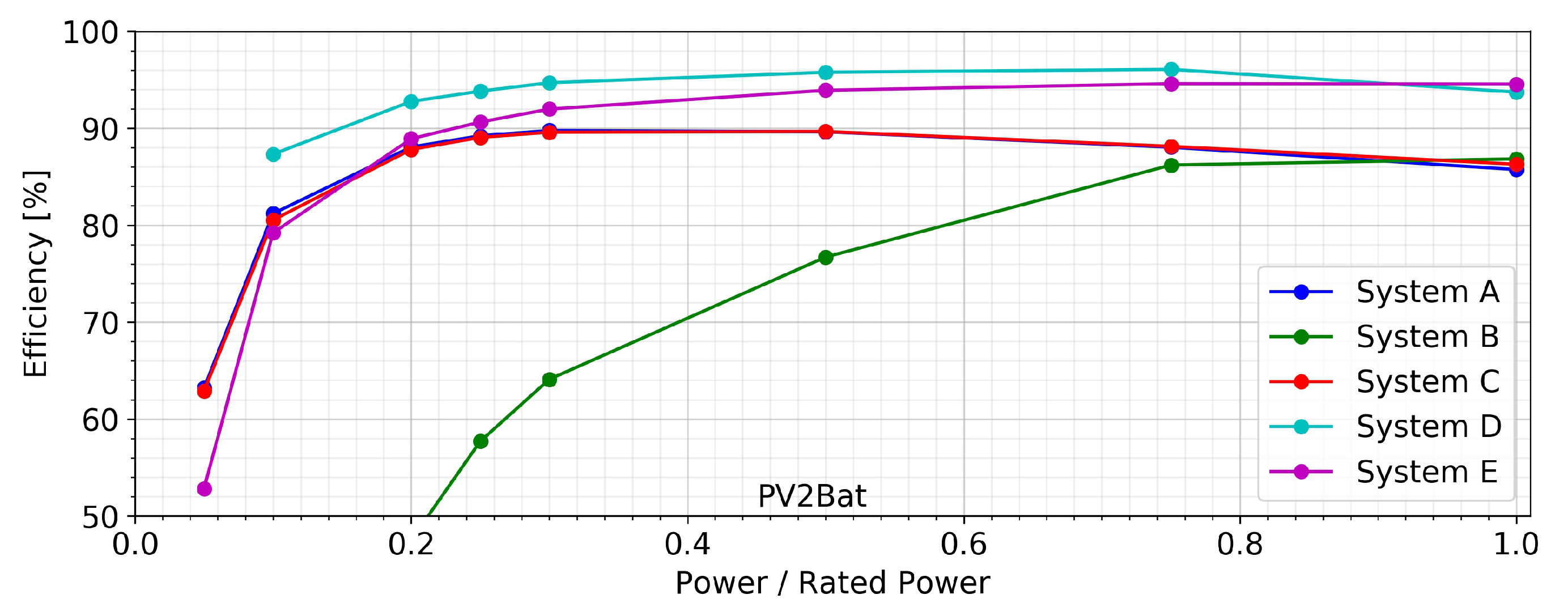
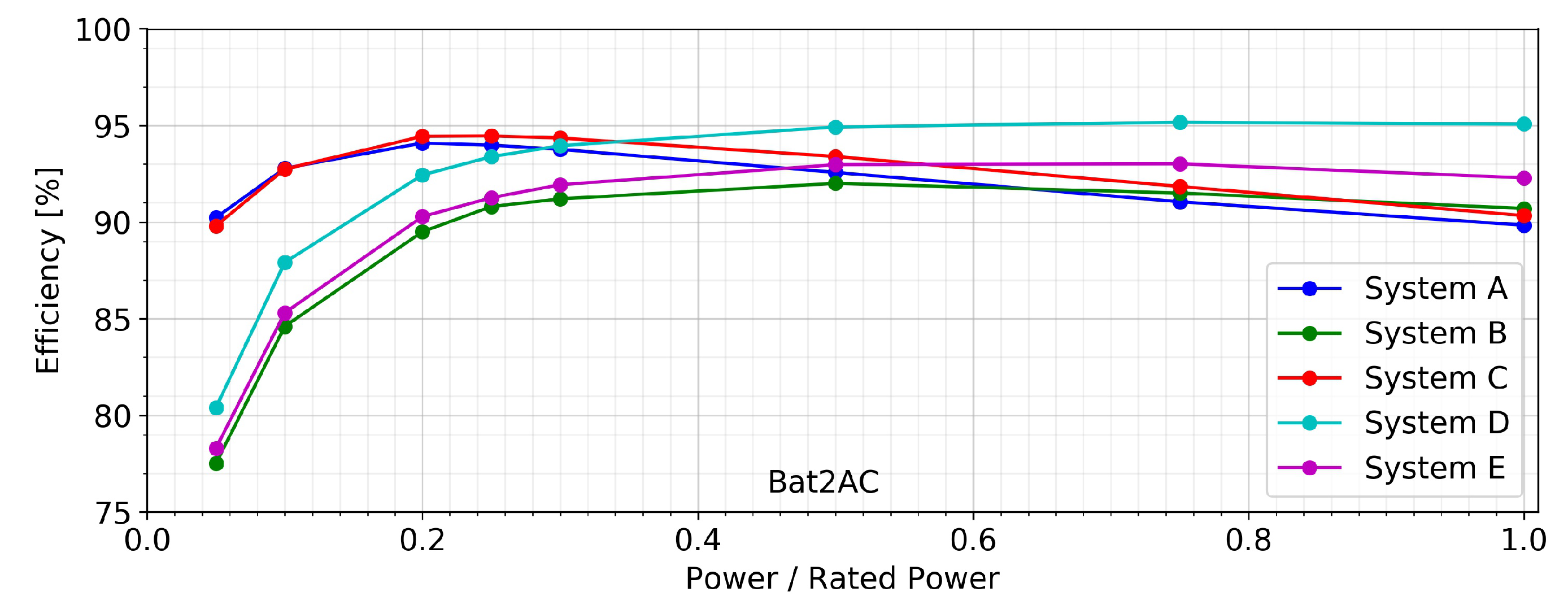
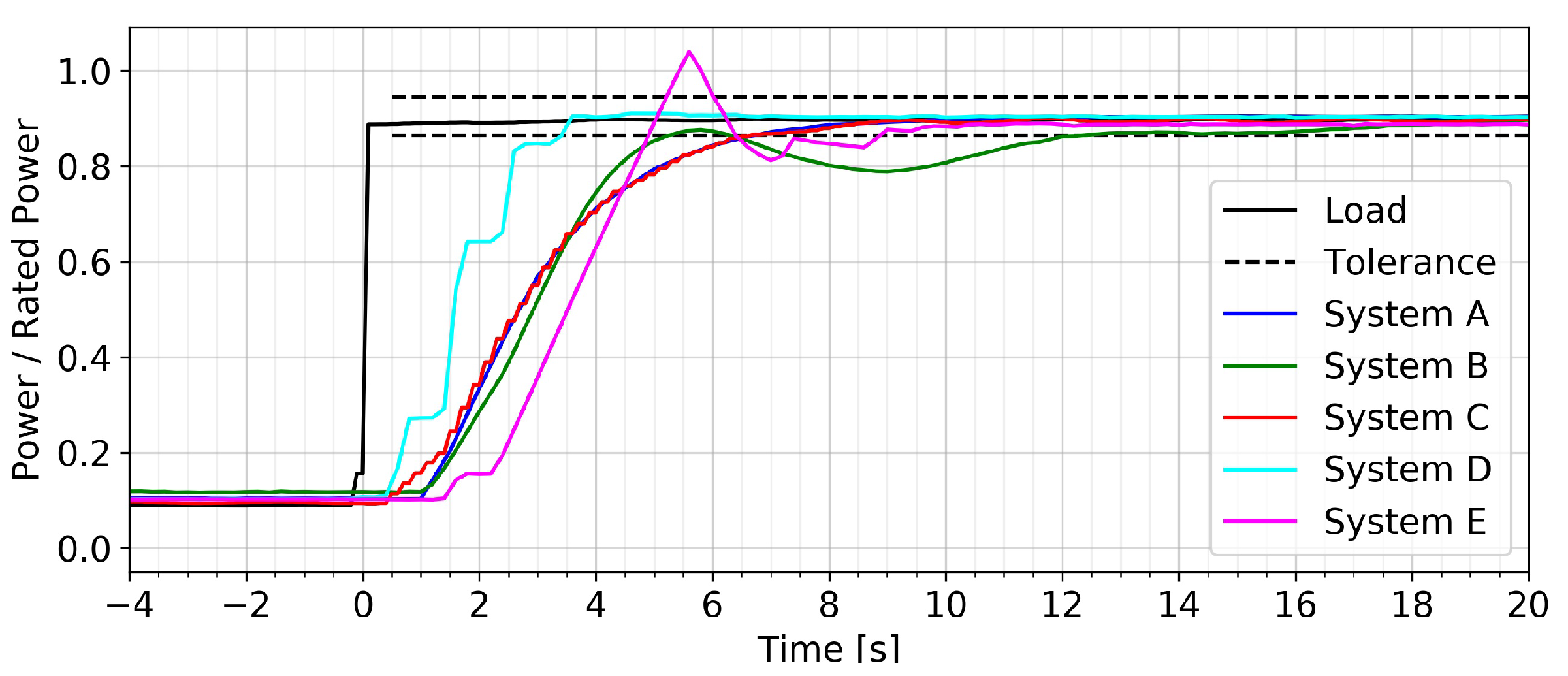

| Topology | Power Conversion | |||
|---|---|---|---|---|
| PV2Bat | PV2Grid | PV2Load | Bat2Load | |
| AC-coupled | PV2AC | PV2AC | PV2AC | Bat2AC |
| AC2Bat | ||||
| DC-coupled | PV2Bat | PV2AC | PV2AC | Bat2AC |
| Generator-coupled | PV2Bat | PV2AC | PV2AC | Bat2PV |
| PV2AC | ||||
| Operating State | PV Power, Load Power and SoC | Power Flows |
|---|---|---|
| Local consumption | ||
| + Charging | ||
| Local consumption | ||
| + Feed-in | ||
| Local consumption | ||
| + Discharging | ||
| Local consumption | ||
| Parameter | Power Level | |||||||
|---|---|---|---|---|---|---|---|---|
| 0.05 | 0.1 | 0.2 | 0.25 | 0.3 | 0.5 | 0.75 | 1 | |
| [%] | 3 | 5 | 7 | 8 | 12 | 29 | 25 | 11 |
| [%] | 4 | 9 | 16 | 19 | 17 | 11 | 10 | 13 |
| [%] | 3 | 6 | 13 | 0 | 10 | 48 | 0 | 20 |
| [%] | 36 | 35 | 29 | |||||
| Parameter | System | ||||
|---|---|---|---|---|---|
| A | B | C | D | E | |
| Battery coupling | AC | AC | AC | DC | DC |
| Battery technology | Li-Ion | Li-Ion | Li-Ion | Li-Ion | Li-Ion |
| [kWh] | 5.3 | 4.9 | 7.4 | 2.2 | 7.3 |
| [V] | 48 | 48 | 48 | 150 | 192 |
| [kW] | 3.4 | 1.2 | 3.4 | 1.9 | 5.0 |
| [kW] | 3.4 | 2.0 | 3.4 | 1.9 | 4.6 |
| [kW] | 4.6 | 4.6 | 4.6 | 4.6 | 5.0 |
| Parameter | System | ||||
|---|---|---|---|---|---|
| A | B | C | D | E | |
| [kWh] | 72.5 | 72.6 | 72.5 | 71.8 | 71.8 |
| [kWh] | 99.1 | 99.1 | 99.1 | 99.1 | 107.7 |
| [kWh] | 98.0 | 98.1 | 97.9 | 97.0 | 103.5 |
| [kWh] | 94.1 | 93.7 | 93.6 | ||
| [kWh] | 28.7 | 26.1 | 35.4 | ||
| [kWh] | 22.3 | 17.8 | 26.7 | ||
| [kWh] | 26.3 | 22.9 | 32.4 | 13.5 | 30.1 |
| [kWh] | 25.0 | 21.5 | 29.1 | 13.0 | 28.4 |
| [kWh] | 87.8 | 85.5 | 84.9 | 91.0 | 86.8 |
| [kWh] | 33.6 | 39.5 | 30.8 | 41.3 | 34.4 |
| [kWh] | 49.0 | 52.0 | 43.1 | 60.1 | 46.7 |
| [kWh] | 39.6 | 34.5 | 41.6 | 30.6 | 40.1 |
| [%] | 98.9 | 98.9 | 98.8 | 97.9 | 96.0 |
| [%] | 95.0 | 94.6 | 94.4 | ||
| [%] | 91.6 | 88.0 | 91.6 | ||
| [%] | 95.1 | 93.9 | 89.9 | 96.7 | 94.2 |
| [%] | 89.3 | 82.8 | 91.5 | ||
| Parameter | 7-Day Test | ||||
|---|---|---|---|---|---|
| A | B | C | D | E | |
| [kWh] | 99.1 | 99.1 | 99.1 | 99.1 | 107.7 |
| [kWh] | 87.8 | 85.5 | 84.9 | 91.0 | 86.8 |
| [%] | 88.6 | 86.2 | 85.6 | 91.9 | 80.6 |
| [kWh] | 39.6 | 34.5 | 41.6 | 30.6 | 40.1 |
| [kWh] | 44.0 | 43.0 | 50.1 | 31.9 | 48.8 |
| [%] | 89.9 | 80.2 | 83.0 | 96.2 | 82.2 |
| [kWh] | 33.6 | 39.5 | 30.8 | 41.3 | 34.4 |
| [kWh] | 28.5 | 29.6 | 22.4 | 39.9 | 23.0 |
| [kWh] | 49.0 | 52.0 | 43.1 | 60.1 | 46.7 |
| [kWh] | 54.1 | 56.0 | 48.0 | 65.8 | 49.3 |
| [kWh] | 72.5 | 72.6 | 72.5 | 71.8 | 71.8 |
| [€] | 3.53 | 4.83 | 3.46 | 4.36 | 4.04 |
| [€] | 1.48 | 1.58 | 0.50 | 3.29 | 0.15 |
| [€] | 20.31 | 20.34 | 20.29 | 20.10 | 20.10 |
| [%] | 89.1 | 82.7 | 85.1 | 93.6 | 82.0 |
| [%] | 95.8 | 95.8 | 95.8 | 95.7 | 91.9 |
| [%] | 93.2 | 89.0 | 92.8 | ||
| [%] | 94.5 | 91.3 | |||
| [%] | 92.7 | 89.7 | 93.1 | 92.9 | 90.7 |
| [%] | 95.1 | 95.1 | 92.1 | 95.8 | 93.0 |
| [%] | 78.7 | 72.7 | 76.2 | 84.0 | 77.0 |
| Method | Requirement | ||||||
|---|---|---|---|---|---|---|---|
| R1 | R2 | R3 | R4 | R5 | R6 | R7 | |
| Hybrid Benchmark | + | + | ++ | + | + | + | + |
| SPI | + | ++ | + | ++ | 0 | - | - |
| - | ++ | ++ | + | 0 | + | 0 | |
Publisher’s Note: MDPI stays neutral with regard to jurisdictional claims in published maps and institutional affiliations. |
© 2020 by the authors. Licensee MDPI, Basel, Switzerland. This article is an open access article distributed under the terms and conditions of the Creative Commons Attribution (CC BY) license (http://creativecommons.org/licenses/by/4.0/).
Share and Cite
Niedermeyer, F.; Braun, M. Comparison of Performance-Assessment Methods for Residential PV Battery Systems. Energies 2020, 13, 5529. https://doi.org/10.3390/en13215529
Niedermeyer F, Braun M. Comparison of Performance-Assessment Methods for Residential PV Battery Systems. Energies. 2020; 13(21):5529. https://doi.org/10.3390/en13215529
Chicago/Turabian StyleNiedermeyer, Fabian, and Martin Braun. 2020. "Comparison of Performance-Assessment Methods for Residential PV Battery Systems" Energies 13, no. 21: 5529. https://doi.org/10.3390/en13215529
APA StyleNiedermeyer, F., & Braun, M. (2020). Comparison of Performance-Assessment Methods for Residential PV Battery Systems. Energies, 13(21), 5529. https://doi.org/10.3390/en13215529





